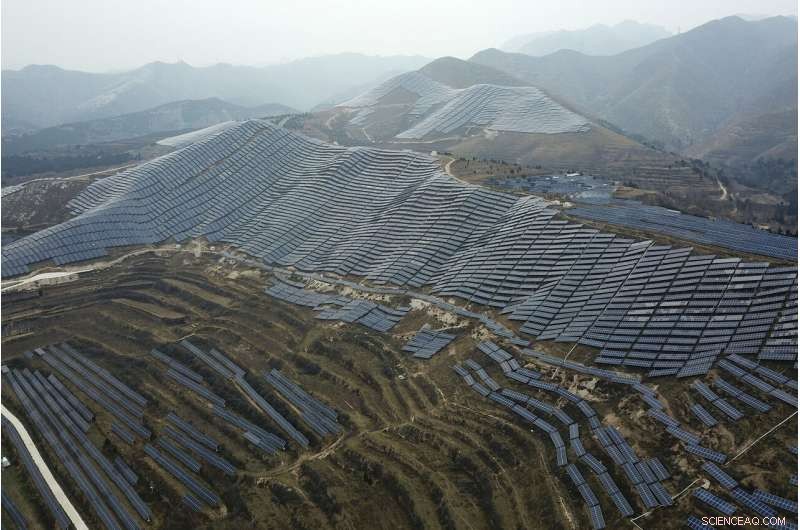
En ce 27 novembre, 2019, photo, une installation de panneaux solaires est visible dans le comté de Ruicheng, dans la province du Shanxi (centre de la Chine). Alors que les dirigeants mondiaux se réunissent à Madrid pour discuter de la manière de ralentir le réchauffement de la planète, un projecteur tombe sur la Chine, premier émetteur de gaz à effet de serre. La Chine brûle environ la moitié du charbon utilisé dans le monde chaque année. Mais c'est aussi le premier marché des panneaux solaires, éoliennes et véhicules électriques. (Photo AP/Sam McNeil)
Alors que les dirigeants mondiaux se réunissent en Espagne pour discuter de la manière de ralentir le réchauffement de la planète, les projecteurs sont braqués sur la Chine, premier émetteur de gaz à effet de serre.
La Chine brûle environ la moitié du charbon utilisé dans le monde chaque année. Entre 2000 et 2018, ses émissions annuelles de carbone ont presque triplé, et il représente maintenant environ 30 % du total mondial. Mais c'est aussi le premier marché des panneaux solaires, éoliennes et véhicules électriques, et elle fabrique environ les deux tiers des cellules solaires installées dans le monde.
"Nous assistons à de nombreuses contradictions dans le développement énergétique de la Chine, " a déclaré Kevin Tu, un chercheur basé à Pékin avec le Center on Global Energy Policy de l'Université de Columbia. "C'est le plus grand marché du charbon et le plus grand marché de l'énergie propre au monde."
Ce paradoxe apparent est possible en raison de l'ampleur de la demande énergétique de la Chine.
Mais alors que l'économie chinoise ralentit à son niveau le plus bas en un quart de siècle, soit une croissance d'environ 6 %, selon les statistiques gouvernementales, les décideurs politiques doublent leur soutien au charbon et à d'autres industries lourdes, les piliers traditionnels du système énergétique et de l'économie de la Chine. À la fois, le pays réduit les subventions aux énergies renouvelables.
Lors du sommet annuel des Nations Unies sur le climat, cette année à Madrid, les représentants du gouvernement mettront la dernière main à la mise en œuvre de l'Accord de Paris de 2015, qui s'est fixé comme objectif de limiter le réchauffement futur à 1,5 à 2 degrés Celsius au-dessus des niveaux préindustriels. Les nations peuvent décider elles-mêmes comment y parvenir.
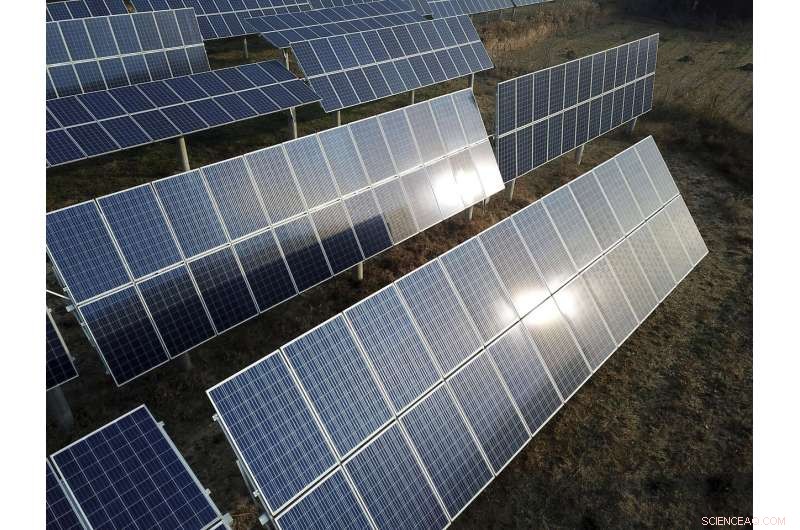
En ce 28 novembre, 2019, photo, une installation de panneaux solaires est visible dans le comté de Ruicheng, dans la province du Shanxi (centre de la Chine). Alors que les dirigeants mondiaux se réunissent à Madrid pour discuter de la manière de ralentir le réchauffement de la planète, un projecteur tombe sur la Chine, premier émetteur de gaz à effet de serre. La Chine brûle environ la moitié du charbon utilisé dans le monde chaque année. Mais c'est aussi le premier marché des panneaux solaires, éoliennes et véhicules électriques. (Photo AP/Sam McNeil)
La Chine s'était auparavant engagée à faire passer son mix énergétique à 20 % d'énergies renouvelables, y compris l'énergie nucléaire et hydroélectrique. Les experts du climat s'accordent généralement à dire que les objectifs initiaux promis à Paris ne suffiront pas à atteindre l'objectif, et l'année prochaine, les nations sont tenues d'articuler des objectifs plus ambitieux.
Les espoirs que la Chine offrirait de faire beaucoup plus s'estompent.
Des reportages récents dans les médias et des images satellites suggèrent que la Chine construit ou envisage d'achever de nouvelles centrales au charbon d'une capacité totale de 148 gigawatts, soit presque l'équivalent de la totalité de la capacité de production d'électricité au charbon de l'Union européenne au cours des prochaines années. selon une analyse de Global Energy Monitor, une organisation à but non lucratif basée à San Francisco.
Séparément, les investissements dans les énergies renouvelables en Chine ont chuté de près de 40 % au premier semestre 2019 par rapport à la même période l'an dernier, selon Bloomberg New Energy Finance, un organisme de recherche. Le gouvernement a réduit les subventions à l'énergie solaire.
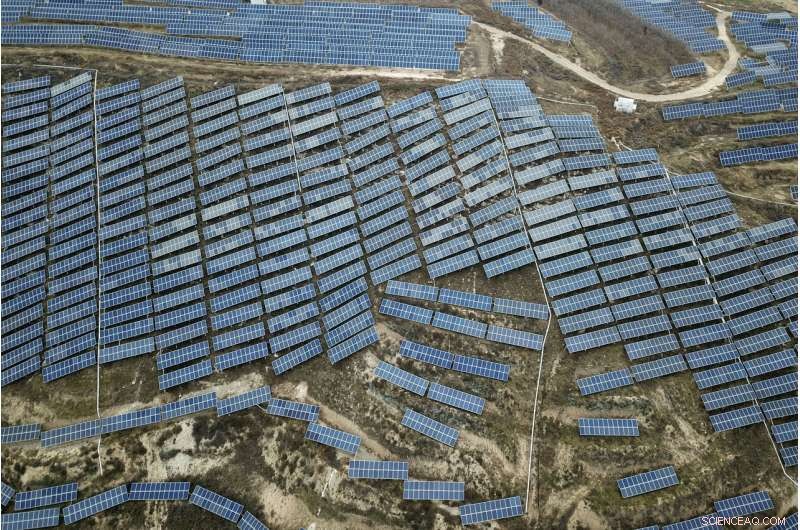
En ce 27 novembre, 2019, photo, une installation de panneaux solaires est visible dans le comté de Ruicheng, dans la province du Shanxi (centre de la Chine). Alors que les dirigeants mondiaux se réunissent à Madrid pour discuter de la manière de ralentir le réchauffement de la planète, un projecteur tombe sur la Chine, premier émetteur de gaz à effet de serre. La Chine brûle environ la moitié du charbon utilisé dans le monde chaque année. Mais c'est aussi le premier marché des panneaux solaires, éoliennes et véhicules électriques. (Photo AP/Sam McNeil)
La semaine dernière à Pékin, Le vice-ministre chinois de l'Écologie et de l'Environnement a déclaré aux journalistes que les sources de combustibles non fossiles représentaient déjà 14,3% du mix énergétique du pays. Il n'a pas indiqué que la Chine adopterait bientôt des objectifs plus stricts.
« Nous sommes toujours confrontés à des défis de développement de notre économie, améliorer les conditions de vie des gens, " a déclaré Zhao Yingmin.
La Chine est alternativement présentée comme le pire méchant climatique du monde ou son potentiel sauveur d'énergie propre, mais les deux superlatifs sont quelque peu déplacés.
En tant qu'économie à croissance rapide, il était toujours inévitable que les demandes énergétiques de la Chine grimpent en flèche. La seule question était de savoir si le pays pouvait alimenter une partie suffisamment importante de son économie avec des énergies renouvelables pour freiner la croissance des émissions.
De nombreux observateurs ont pris espoir d'une brève baisse des émissions de carbone de la Chine entre 2014 et 2016, ainsi que la déclaration du dirigeant chinois Xi Jinping en 2017 selon laquelle la Chine avait "pris un rôle moteur dans la coopération internationale pour répondre au changement climatique".
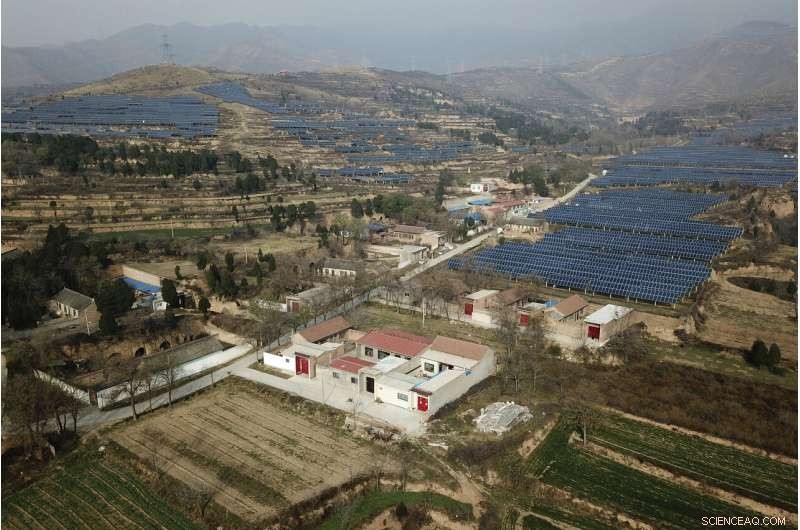
En ce 28 novembre, 2019, photo, une installation de panneaux solaires est visible dans le comté de Ruicheng, dans la province du Shanxi (centre de la Chine). Alors que les dirigeants mondiaux se réunissent à Madrid pour discuter de la manière de ralentir le réchauffement de la planète, un projecteur tombe sur la Chine, premier émetteur de gaz à effet de serre. La Chine brûle environ la moitié du charbon utilisé dans le monde chaque année. Mais c'est aussi le premier marché des panneaux solaires, éoliennes et véhicules électriques. (Photo AP/Sam McNeil)
Aujourd'hui, l'intérêt renouvelé du pays pour le charbon est décevant.
"Maintenant, on a le sentiment que plutôt que d'être un leader, La Chine est celle qui est en décalage, " a déclaré Lauri Myllyvirta, analyste principal au Centre de recherche sur l'énergie et l'air pur à Helsinki. Il note que plusieurs pays développés, dont l'Allemagne, La Corée du Sud et les États-Unis réduisent rapidement leur dépendance à l'énergie au charbon.
Les combustibles fossiles tels que le charbon, l'essence et le gaz naturel libèrent du dioxyde de carbone dans l'atmosphère, trapping heat and changing the climate. Coal is the biggest culprit.
L'année dernière, coal consumption in the United States hit the lowest level in nearly 40 years, selon l'Energy Information Administration des États-Unis.
One place to consider the rise, pause and rise again of China's coal sector is Shanxi province—a vast mountainous region in central China.
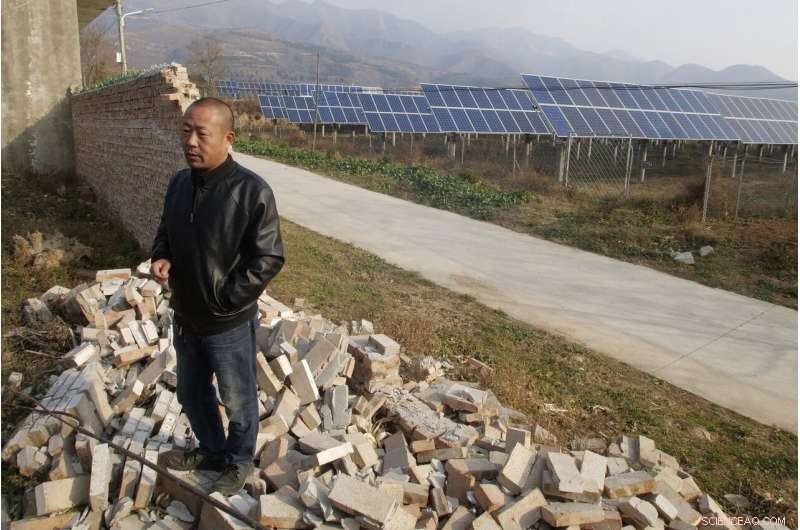
In this Nov. 28, 2019, photo, Chan Shicun, a construction materials trader, points to a wall he said local authorities destroyed after a disagreement with a massive government-backed solar project in Ruicheng County in central China's Shanxi Province. As world leaders gather in Madrid to discuss how to slow the warming of the planet, a spotlight is falling on China, the top emitter of greenhouse gases. China burns about half the coal used globally each year. Yet it's also the leading market for solar panels, wind turbines and electric vehicles. (AP Photo/Sam McNeil)
Shanxi is the heart of China's traditional coal country, dotted with large mines, but also the site of some of the country's largest solar and wind-power projects, according to state media.
During most of the past 30 years of rapid economic growth, the coal business boomed in Shanxi and nearby provinces. As China's cities and industries expanded, coal supplied much of that power, and China surpassed the U.S. as the world's top carbon emitter in 2006.
But after climbing sharply for two decades, China's emissions stalled around 2013 and then declined slightly in 2015 and 2016, according to Global Carbon Budget, which tracks emissions worldwide. This dip came as Chinese leaders declared a "war on pollution" and suspended the construction of dozens of planned coal power plants, including some in Shanxi.
À la fois, the government required many existing coal operators to install new equipment in smokestacks to remove sulfur dioxide, nitrous oxide and other hazardous substances. About 80% of coal plants now have scrubbers, said Alvin Lin, Beijing-based China climate and energy policy director for the Natural Resources Defense Council, a nonprofit.
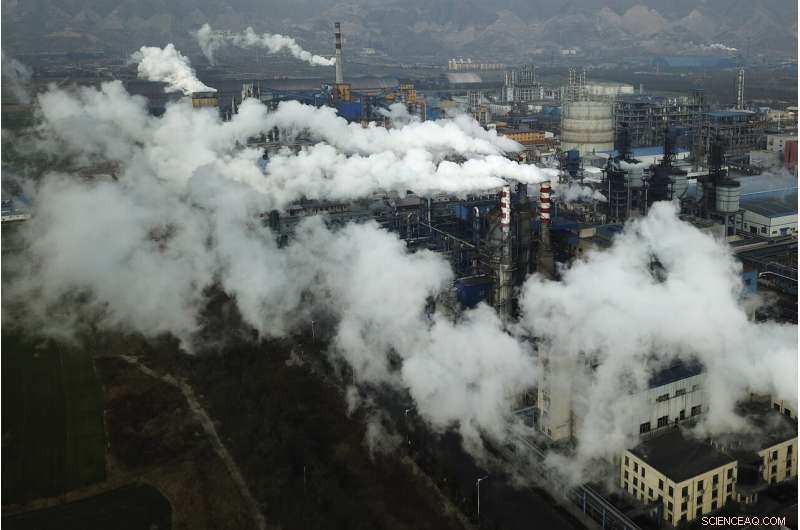
In this Nov. 28, 2019, photo, smoke and steam rise from a coal processing plant that produces carbon black, an ingredient in steel manufacturing, in Hejin in central China's Shanxi Province. As world leaders gather in Madrid to discuss how to slow the warming of the planet, a spotlight is falling on China, the top emitter of greenhouse gases. China burns about half the coal used globally each year. Yet it's also the leading market for solar panels, wind turbines and electric vehicles. (AP Photo/Sam McNeil)
Par conséquent, the air quality in many Chinese cities, including Beijing, improved significantly between 2013 and 2017. Residents long accustomed to wearing face masks and running home air-filter machines enjoyed a reprieve of more "blue sky days, " as low-pollution days are known in China.
Annual levels of PM 2.5—a tiny but dangerous pollutant—dropped by roughly a third across China between 2013 and 2017, from 61.8 to 42 micrograms per cubic meter, according to scientists at Beijing's Tsinghua University and other institutions. They made the report in November in the Actes de l'Académie nationale des sciences , a peer-reviewed journal.
"That's a big improvement, although in terms of safe air quality, we're still not there yet, " Lin said. China's pollution levels are still well above standards set by the World Health Organization.
While these retrofitted coal plants emit fewer pollutants that harm human health, the scrubbers do not reduce greenhouse gases. "The new plants are good for air quality, but you still have all that carbon dioxide that goes into the atmosphere, " Lin said.
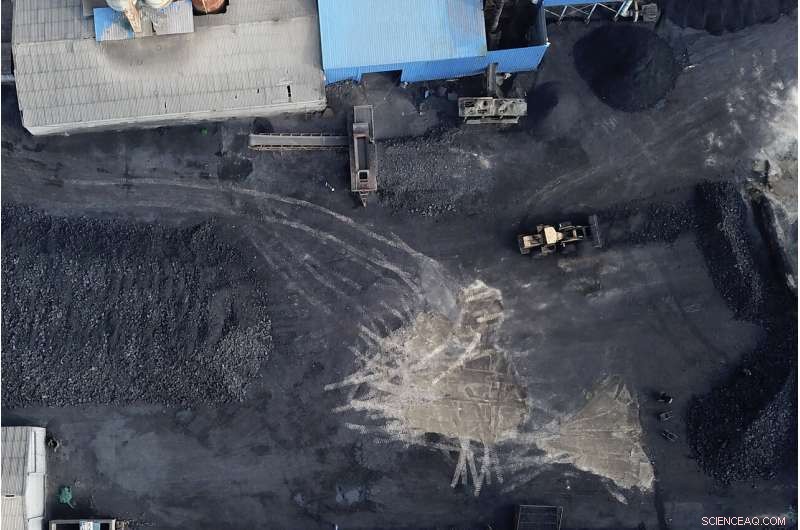
In this Nov. 28, 2019, photo, a coal storage facility is seen in Hejin in central China's Shanxi Province. As world leaders gather in Madrid to discuss how to slow the warming of the planet, a spotlight is falling on China, the top emitter of greenhouse gases. China burns about half the coal used globally each year. Yet it's also the leading market for solar panels, wind turbines and electric vehicles. (AP Photo/Sam McNeil)
In the past three years, China's carbon emissions have begun to rise again, according to Global Carbon Budget.
That trend was evident in the first half of 2019, when China's carbon emissions from fossil fuels and concrete production rose 4%, compared with the same period last year, according to Myllyvirta's preliminary analysis of Chinese government data.
The coming winter in Beijing may see a return of prolonged smog, as authorities loosen environmental controls on heavy industry—in part to compensate for other slowing sectors in the economy. Cement and steel production remain both energy intensive and heavily polluting.
Permits for new coal plants proliferated after regulatory authority was briefly devolved from Beijing to provincial governments, which see construction projects and coal operations as boosts to local economies and tax bases, said Ted Nace, executive director of Global Energy Monitor.
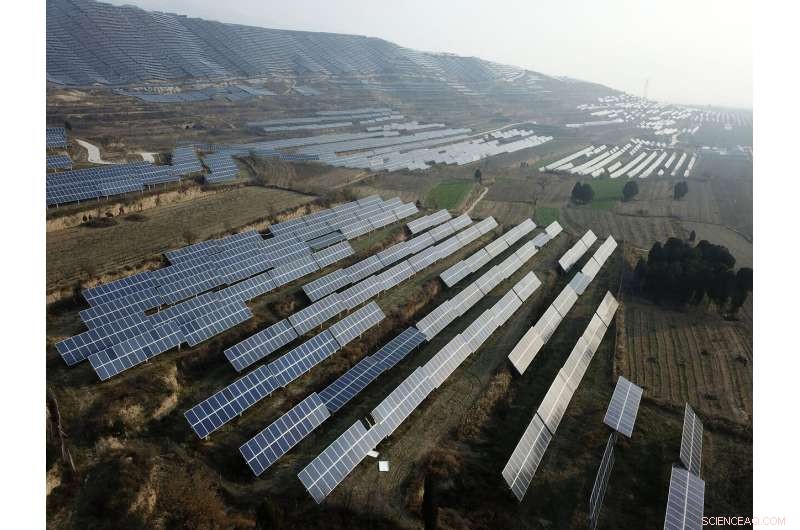
In this Nov. 28, 2019, photo, a solar panel installation is seen in Ruicheng County in central China's Shanxi Province. As world leaders gather in Madrid to discuss how to slow the warming of the planet, a spotlight is falling on China, the top emitter of greenhouse gases. China burns about half the coal used globally each year. Yet it's also the leading market for solar panels, wind turbines and electric vehicles. (AP Photo/Sam McNeil)
"It's as though a boa constructor swallowed a giraffe, and now we're watching that bulge move through the system, " said Nace. In China, it takes about three years to build a coal plant.
In November, Premier Li Keqiang gave a speech to policymakers emphasizing the importance of domestic coal to energy security.
But because China's coal-power expansion is growing faster than energy demand, overcapacity "is a serious concern now, " said Columbia University's Tu.
And once new infrastructure is built, it's hard to ignore.
"It will be politically difficult to tear down a brand-new coal plant that's employing people and supporting a mining operation. It will make it more difficult for China to transition away from coal, " Nace said.
The world has already warmed by 1 degree Celsius. All scenarios envisioned by the Intergovernmental Panel on Climate Change for holding planetary warming to around 1.5 degrees Celsius involve steep worldwide reductions in coal-power generation.
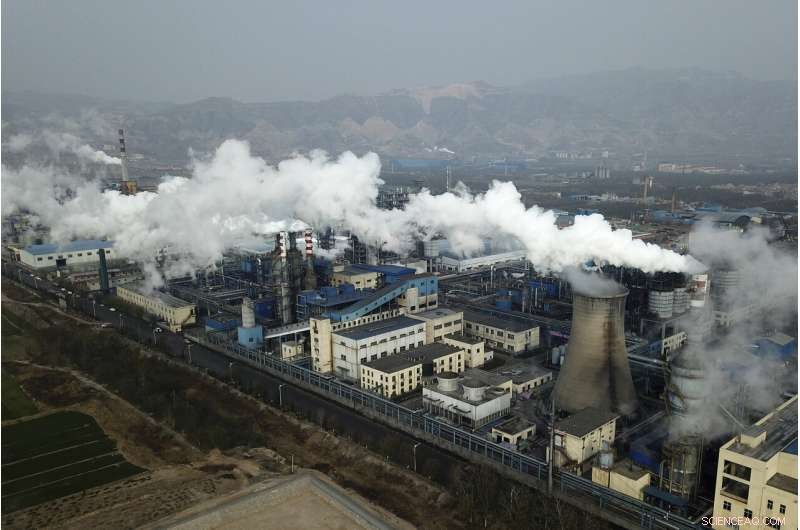
In this Nov. 28, 2019, photo, smoke and steam rise from a coal processing plant that produces carbon black, an ingredient in steel manufacturing, in Hejin in central China's Shanxi Province. As world leaders gather in Madrid to discuss how to slow the warming of the planet, a spotlight is falling on China, the top emitter of greenhouse gases. China burns about half the coal used globally each year. Yet it's also the leading market for solar panels, wind turbines and electric vehicles. (AP Photo/Sam McNeil)
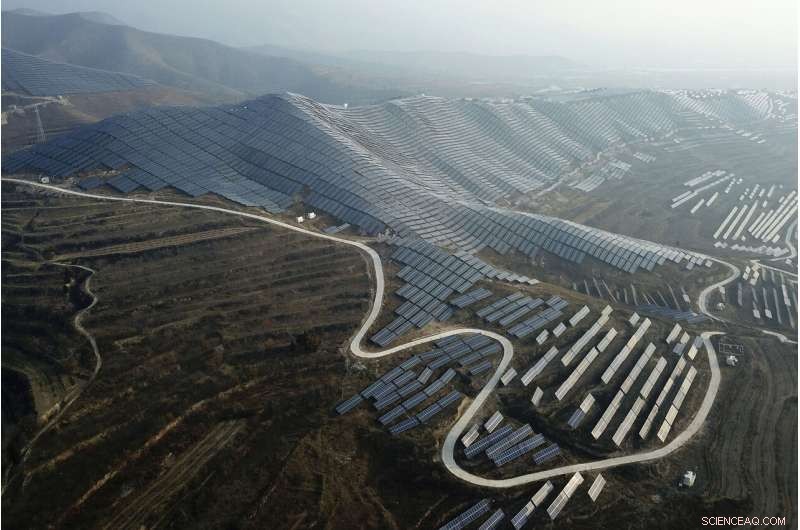
In this Nov. 28, 2019, photo, a solar panel installation is seen in Ruicheng County in central China's Shanxi Province. As world leaders gather in Madrid to discuss how to slow the warming of the planet, a spotlight is falling on China, the top emitter of greenhouse gases. China burns about half the coal used globally each year. Yet it's also the leading market for solar panels, wind turbines and electric vehicles. (AP Photo/Sam McNeil)
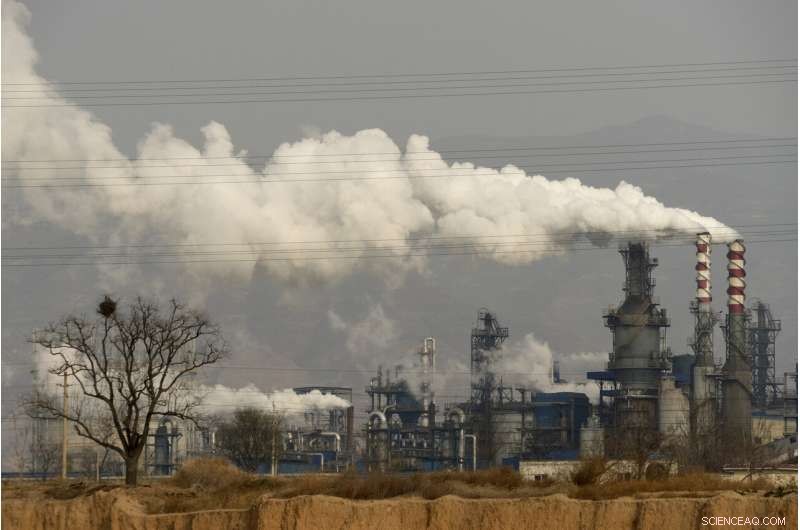
In this Nov. 28, 2019, photo, smoke and steam rise from a coal processing plant that produces carbon black, an ingredient in steel manufacturing, in Hejin in central China's Shanxi Province. As world leaders gather in Madrid to discuss how to slow the warming of the planet, a spotlight is falling on China, the top emitter of greenhouse gases. China burns about half the coal used globally each year. Yet it's also the leading market for solar panels, wind turbines and electric vehicles. (AP Photo/Olivia Zhang)
In that effort, other countries rely on China to manufacture most of the solar panels installed worldwide, according to an analysis in the journal Science co-authored by Jonas Nahm, an energy expert at Johns Hopkins University.
"If we have any chance to meet climate targets, we have to do a lot by 2030—and we won't be able to do it without China's clean-energy supply chain, " Nahm said.
China's manufacturing helped bring down the cost of solar panels by 80% between 2008 and 2013. Prices for wind turbines and lithium-ion batteries also dropped significantly, according to Bloomberg New Energy Finance.
"China has a really mixed record. On the one hand, it's seen rapidly rising emissions over the past two decades, " Nahm said. "On the other hand, it's shown it's able to innovate around manufacturing—and make new energy technologies available at scale, faster and cheaper."
© 2019 La Presse Associée. Tous les droits sont réservés.